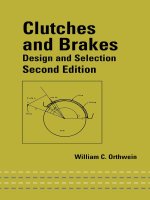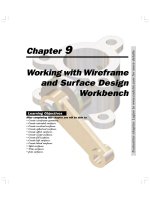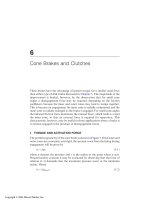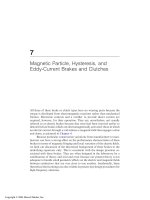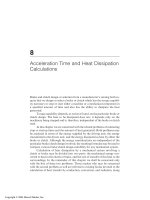Training manual generator introduction and electrical design
Bạn đang xem bản rút gọn của tài liệu. Xem và tải ngay bản đầy đủ của tài liệu tại đây (7.12 MB, 30 trang )
Generator Introduction and
Electrical Design
2013
Turbine Generator BG
DAE IL SONG,
This document is the informational asset of Doosan Heavy Industries & Construction. Thus, unauthorized access, revision, distribution and copying of this document are strictly prohibited.
1. Generator Overview
2
Generator in Power Plant
“Generator”
BOP
The generator is a Energy Converter for Electric Power from Mechanical Energy.
Boiler
Turbine / Generator
3
Generator Electrical Design Concept
Electromagnetic Machine
Torque
Mechanical
Speed
Mechanical
Input
Loss
ElectroMagnetic
Field
Electrical
Loss
Voltage
Current
Electric
Output
4
Generator Electrical Design Concept
< Basic Electromagnetic >
• Ampere’s Law : Currents Create Magnetic Fields
• Faraday’s Law : Changing Magnetic Flux Induces Voltage
5
Generator Overview
Cooling Material : H2, Water
Stator Core
Inner Shield
Outer Shield
Bearing,
Hydrogen Seal,
Oil Deflectors
EXCITER
Armature
Winding
TURBINE
Rotor
Rotor Fan
Retaining Ring
Cooler Dome
Field Coil
Stator Foot
Stator Frame
High Voltage
Bushing
6
Generator Type
Air-Cooled
Hydrogen-Cooled
Water-Cooled
• 100 ~ 150 MW
• 150MW ~ 400 MW
• Above 400 MW
• O/V(Open Ventilated)
•
Vertical Cooler Design
• TEWAC (Totally Enclosed
Water to Air-cooled)
•
Gas Control System
• Twin Dome Cooler
Design
•
Shaft Seal Oil System
• Gas Control System
• Shaft Seal Oil System
• Stator Winding Liquid
Cooling System
7
Generator Product Lineup
4 Pole Steam Turbine
Generator
Water-Cooled
2 Pole Steam Turbine
Generator
HydrogenCooled
Gas/Steam Turbine
Generator
Air Cooled
: Below 150 MW
H2 Cooled
: 150 MW~400
MW
• H2/Water Cooled : Above 400 MW
•
•
Air-Cooled
Gas/Steam Turbine
Generator
0
50
100
150
200
350
400
600
800
1000
1500
Generator Rating (MW)
8
Air-Cooled Generator
Cirebon Projects
60Hz, 150MW Air-Cooled Generator
OCISE Co. Ltd. in KOREA
Rated MVA
168.7 MVA
Rated Voltage
17 kV
Power Factor
0.90
Cold Air Temp
42˚C
RPM
3600
▲ Air-cooled generator in the
progress of manufacturing
9
Hydrogen-Cooled Generator
60Hz H2-Cooled STG 300MW 60Hz H2-Cooled GTG 200MW
Korean Southern Power Co. Ltd. (KOSPO in Korea)
▼ Hydrogen-cooled generator installed in site
GTG
Rated MVA
STG
240 MVA
Rated Voltage
18 kV
Power Factor
0.90
H2 Pressure
Rated MVA
45 PSIG(3.16kg/cm )
2
RPM
3600
Cold Gas Temp
40˚C
340 MVA
Rated Voltage
18 kV
Power Factor
0.90
H2 Pressure
60 PSIG(4.22kg/cm2 )
RPM
3600
Cold Gas Temp
40˚C
10
Water-Cooled Generator
Shin Kori 3 & 4
50Hz, 700MW Water-Cooled Generator
AES-VCM MONG DUONG POWER COMPANY
in Vietnam
Rated MVA
752.512 MVA
Rated Voltage
23 kV
Power Factor
0.85
H2 Pressure
RPM
Cold Gas
Cooling Water
75 PSIG(5.27kg/cm2 )
3000
46.5˚C
38˚C
▲ MD2 generator in the progress
of manufacturing
11
2. Introduction to Electrical Design
12
Generator Function
GENERATOR
LOAD
Real Power (W)
~
Power System
(Looks Inductive)
Reactive Power (VAR)
Synchronous generator acts
like a capacitor or an
inductance
• Primary function of a synchronous generator is to provide real power to
the system
– This is what the Power Company sells to its customers!
• Secondary function is to become a source or sink of reactive power
(VAR)
– Needed for control of voltage on the grid
13
Select Power Factor
• Power Factor
I
V
V
I
Θ = Power Factor Angle
θ
cos Θ = Power Factor
θ
Capacitive Load
Inductive Load
Current Leads Voltage
Voltage Leads Current
- Lower power factors require greater
excitation, better cooling or else higher
temperatures, more losses, and lower
efficiency
338140kVA
178120kVAR
θ
287420kW
Θ = 31.8
PF = cos(θ) = 0.85
14
Select Rating
• Turbine MW Output
• Closed Cooling Water Temperature
• Codes & Standards
– ANSI C50.13
– IEC 60034
Number of
Poles
kVA Rating
Rated Speed
Armature
Voltage
22 Poles
Poles -- 752510
752510 kVA
kVA -- 3000
3000 RPM
RPM -- 23000
23000 Volts
Volts
639694
639694 kW
kW -- 0.85
0.85 PF
PF -- 0.500
0.500 SCR
SCR -- 75
75 PSIG
PSIG H
H22 Pressure
Pressure
Rated
Kilowatts
Rated
Power Factor
Guaranteed
Short Circuit
Ratio
Rated
Gas
Pressure
15
Generator Electrical Design Concept
kVA const Mar N P f
< Magnetic Flux() Vs Armature Reaction(Mar) >
A. Trade off in the machine
B. Material Cost vs. Cooling Cost
< Design Process>
- Check required kVA
- Evaluate flux and armature reaction
- Decide the magnetic volume, size of the machine, cooling cost
- Iterate to optimize the design
16
Armature Voltage & Flux
Ε 4.44f Ν Φ
f : Frequency
N : Number of turn
Φ : Flux density
17
Armature Current
Ground Insulation System : Micapal HT (Air/H2-Cooled),
Micapal II (Water-Cooled)
Air,H2-Cooled
Water-Cooled
Water-Cooled
Mixed Ratio 2:1
All Hollow
18
Speed & Poles
Frequency
(Hz)
Speed
(RPM)
Number
of Pole
60
3600
2
Fossil Fuel
50
3000
2
Fossil Fuel
60
1800
4
Nuclear Fuel
50
1500
4
Nuclear Fuel
120 f
RPM
Np
- Np : Number of poles
- f : Frequency
-RPM: Rotational speed
Non Salient Pole (2 pole, 4 pole)
Salient Pole
(Hydrogenerator)
19
Short Circuit Ratio
- SCR is as measure of stability,
which means how much the field
current is affected by load variation
- SCR = AFNL/AFSI
( No Load Field Current /
Short Circuit Field Current )
20
Saturation and synchronous impedance curve
To increase SCR
- increase the air-gap
- increase the saturation
B’
- apply bigger machine
Modern Static Excitation Sys.
leads to lower SCR
21
Reactive Capability Curve
- Generator Capability is a related
to gas pressure.
A
- Curve AB is limited by field
winding heating
B
- Curve BC is limited by armature
heating
- Curve CD is limited by end iron
heating
C
D
22
V Curve
- Curve AB is limited by field
winding heating
C
- Curve BC is limited by
armature
heating
- Curve CD is limited by end iron
heating
B
A
D
23
Loss Curve
- Fan & Windage Loss
- Bearing & Friction Loss
- Core Loss
- Stray Load Loss
- Armature I2R Loss
- Field I2R Loss
- Excitation Sys. Loss
24
2.3 Generator Specification
Rotor Surface Loss
Rotor Coil Pump
Effect Loss
Fan
Brush Cooling
Wind
Fan Loss
Loss
..
• Distribution of Loss
- Fan & Windage Loss
.
Lead Resistance
Loss
Stator Coil
Resistance
Loss
Wind Loss
Bearing Loss
Stator Coil
Loss
- Bearing & Friction Loss
- Armature I2R Loss
Mechanical
Loss
Brush Abrasion
Loss
- Field I2R Loss
Fixed
Loss
Total Loss
Resistance
Loss
Iron Loss
- Excitation Sys. Loss
Load Loss
- Miscellaneous Loss
Rotor Coil
Stray Load
Loss
Resistance
Loss
.
Rotor Coil Loss
Stator End
.
Other
Stray Load
Loss
Eddy Current
Loss at
Eddy Current Loss
Eddy Current Loss
on Rotor Surface
of Stator Coil
.
- Stray Load Loss
Friction
Loss
Sealing Loss
.
- Core Loss
.
Brush Electrical Loss
25
